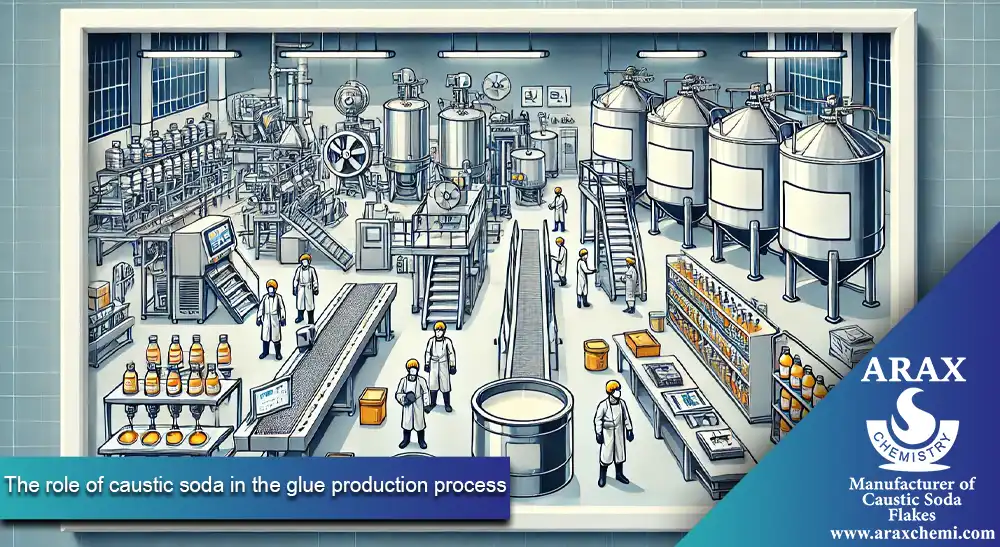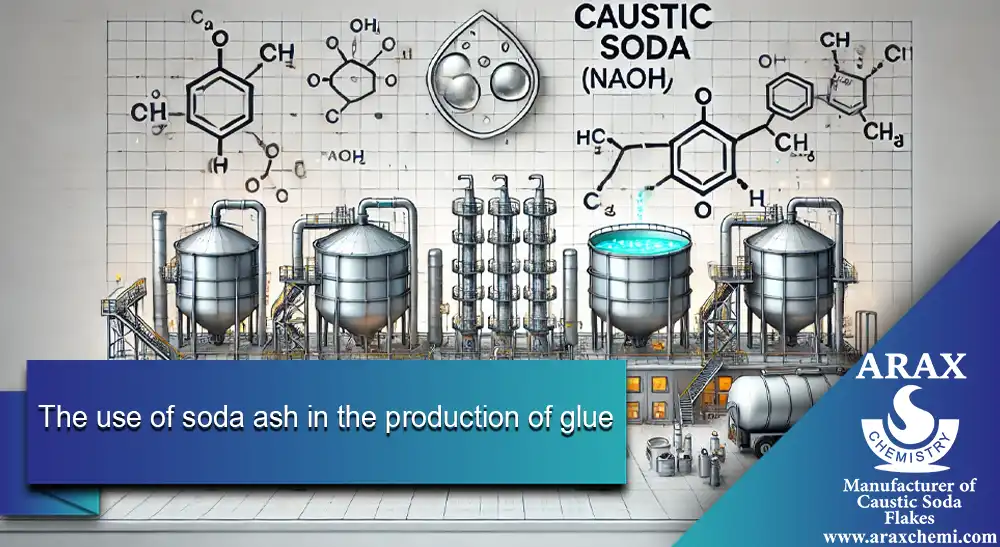Adhesives and sealants have numerous applications across different industries and are used for both partial and comprehensive bonding and sealing. In the production of these products, sodium hydroxide (also known as caustic soda and sodium hydroxide) is utilized to improve the manufacturing process. This article provides a detailed discussion on the applications, advantages, and role of sodium hydroxide in the production of adhesives and sealants. But first, let’s become familiar with sodium hydroxide.
What is Sodium Hydroxide?
Sodium hydroxide is a white solid inorganic compound with the chemical formula NaOH. It consists of sodium cations (Na⁺) and hydroxide anions (OH⁻). Due to its strong alkaline properties and numerous benefits, sodium hydroxide is used in various industries, including the production of pulp and paper, textiles, soaps and detergents, wastewater cleaners, and more. This compound is highly soluble in water and readily absorbs carbon dioxide and moisture.
Common Forms of Sodium Hydroxide Used in Industries
- Liquid Sodium Hydroxide
- Pearl Sodium Hydroxide
- Cylindrical/Bead Sodium Hydroxide
How to Manufacture Adhesives Using Sodium Hydroxide
Purchasing sodium hydroxide is essential for adhesive production, and there are numerous instructions and formulations for its use. For example, here are four of the most common methods for producing starch-based adhesives, which are natural adhesives used in the paper and carton industries:
Instruction 1: Using Sodium Hydroxide in Adhesive Production
- Ingredients:
- 350 grams of tapioca starch
- 3000 grams of corn starch
- 9 liters of water
- 500 milliliters of 20% sodium hydroxide solution
- 55 grams of borax (10 mol H₂O)
- Production Steps:
- Dissolve the starches in water and gradually add the sodium hydroxide solution while stirring the mixture.
- Gently heat the mixture until the tapioca starch gelatinizes (target temperature: 380°C).
- Add borax and continue stirring for an additional 10 minutes to ensure it is dissolved.
- Final Viscosity: 52 seconds
- Gel Temperature: 63°C
Instruction 2: Using Sodium Hydroxide in Adhesive Production
This method is similar to Instruction 1, with the difference that 100 grams of sodium hydroxide is dissolved in 9½ liters of water before adding the starches to the weak sodium hydroxide solution. The final properties of the adhesive will be similar to those produced by the first method.
Instruction 3: Large-Scale Adhesive Production
- Ingredients:
- 7 kilograms of sodium hydroxide
- 925 liters of water
- 300 kilograms of commercial corn starch
- 45 kilograms of wheat starch
- 6 kilograms of borax decahydrate
- Production Steps:
- Dissolve sodium hydroxide in water and heat the mixture to 20-25°C.
- Add the starches and stir rapidly.
- Heat the mixture to approximately 320°C and maintain this temperature for 10 minutes.
- Add borax and stir for another 10 minutes.
Instruction 4: Large-Scale Adhesive Production
- Ingredients:
- 725 kilograms of commercial corn starch
- 90 kilograms of commercial tapioca starch
- Approximately 1910 liters of water
- 14 kilograms of sodium hydroxide
- A solution containing 3 kilograms of boric acid and 2 liters of soda lime silicate solution
- Production Steps:
- Combine the starches and water in a tank and heat to about 280°C.
- Dissolve sodium hydroxide in water and add it to the mixture until the viscosity reaches approximately 28 seconds.
- Add the boric acid and soda lime silicate solution to neutralize the sodium hydroxide and produce the final adhesive.
The Role of Sodium Hydroxide in Adhesive Production

Starch-based adhesives are used as the main ingredient in the production of coating adhesives and various types of adhesives. These adhesives have low solid content, weak bond strength, poor stability, and high stiffness due to the starch retrogradation process (post-reaction process). To overcome these issues, sodium hydroxide solution is used in adhesive manufacturing.
By adding sodium hydroxide in adhesive production, the adhesive’s bonding capacity increases, and its quality improves. The higher the purity of sodium hydroxide, the more significant its effect. Therefore, when purchasing sodium hydroxide, it is essential to pay attention to its purity level. The roles that sodium hydroxide plays in the adhesive production process include:
- Polymerization
- The presence of sodium hydroxide pearls is essential for polymerization in the production of adhesives and sealants. Simply put, the sodium hydroxide solution acts as a catalyst or initiator, facilitating and speeding up the reaction between monomers and polymers. This leads to the formation of cross-linked polymer networks, significantly enhancing the strength, durability, and adhesive properties of adhesives and sealants.
- pH Regulation of Adhesives
- Maintaining the correct pH in the formulation is crucial during adhesive production. Sodium hydroxide, being highly alkaline, is used to adjust the pH, ensuring optimal conditions for various chemical reactions and enhancing the stability and performance of the adhesive and sealant. Additionally, controlling the pH can significantly extend the adhesive’s shelf life.
- Hydrolyzing Silicates
- In the hydrolysis process, water is used to break chemical bonds. In some types of adhesives, silicates are used as binders or fillers. However, to break the chemical bonds in silicates, a strong agent is required, which is where sodium hydroxide becomes important. Sodium hydroxide helps break the silicate bonds, converting them into reactive compounds that improve adhesion and enhance the mechanical properties of the products. This process improves the strength and durability of adhesive bonds.
- Viscosity or Flow Adjustment
- Sodium hydroxide pearls are used to adjust the viscosity of adhesive formulations during production. In other words, this compound is added to control the thickness and fluidity of the adhesive, making it easier for users to apply.
- Cross-Linking and Curing
- Sodium hydroxide pearls play a significant role in the cross-linking and curing processes of adhesives and sealants. The sodium hydroxide solution is used to initiate or accelerate cross-linking reactions, thereby enhancing the adhesive’s bonding strength, durability, flexibility, resistance to environmental factors, and quick drying.
Conclusion
Undoubtedly, the use of sodium hydroxide in adhesive production has led to significant innovations and advancements in the adhesive industry. Sodium hydroxide, through polymerization, pH regulation, hydrolyzing silicates, viscosity adjustment, and cross-linking and curing processes, is widely used in the production of environmentally friendly adhesives and sealants. Manufacturers can produce high-quality adhesives and increase their product sales by leveraging the benefits of sodium hydroxide solutions.
For pricing inquiries, consultations, and product orders, you can contact our experts at Araks Chemical by filling out the form on our contact page, calling our office directly, sending an email, messaging via WhatsApp, or visiting our office in person.
Frequently Asked Questions
- What products is sodium hydroxide used to produce?
Sodium hydroxide is a widely used industrial chemical employed in the production of pulp and paper, adhesives, detergents, packaging materials, agricultural industrial materials, environmental protection, water treatment, food products, hygiene products, textiles, chemical industries, construction, and automotive industries. - What are the dangers of sodium hydroxide?
Skin contact with high concentrations of sodium hydroxide or inhalation of its concentrated vapors can cause severe burns to the eyes, skin, digestive system, or lungs, which can be permanent or even fatal. Additionally, prolonged or repeated contact with low concentrations can cause dermatitis. Repeated inhalation of sodium hydroxide vapors can also result in permanent lung damage. - What role does sodium hydroxide play in adhesive production?
Sodium hydroxide plays a crucial role in polymerization processes, pH regulation of adhesives, hydrolyzing silicates, adjusting viscosity or flow, and cross-linking and curing. These functions help improve the quality and strength of adhesives.

